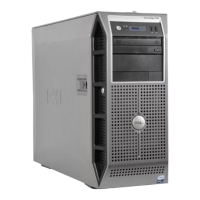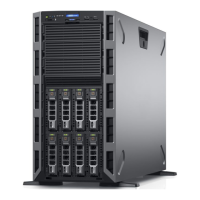7 PowerEdge T320 Technical Guide
System features 2
Compared to the previous-generation PowerEdge T310, the T320 supports up to 100% more
processor cores, up to 300% more internal storage capacity, PCIe 2.0 and 3.0 I/O slots, and
advanced, enterprise-class memory protection including memory sparing and memory mirroring
previously not found in one-socket servers. In addition, the T320 is Fresh Air compliant, offers
optional failsafe hypervisors and support for an optional, internal graphics processing unit (GPU),
and the improved acoustics make the T320 perfect for the quiet office environment.
Comparison of PowerEdge systems
The 12
th
generation PowerEdge T320 server replaces the T310. Table 2 compares some of the T320
features to those of the T310.
Table 2. Comparing the PowerEdge T310 to PowerEdge T320
Intel Xeon processor 3400 product
family
Intel Xeon processor E5-2400 and E5-2400 v2
product families, Intel Xeon processor E5-1410,
Intel Pentium processor 1400 product family
Up to 6 x DDR3 RDIMM or 4 x
DDR3 UDIMM
Up to 6 x DDR3 RDIMM and UDIMM up to
1600MT/s
Up to 4 x 3.5”or 2.5” hot plug or
cabled
Up to 16 x 2.5“ or 8 x 2.5”/3.5“ hot plug or
4 x 3.5” cabled
PERC 6/i, SAS 6/iR, PERC 6/E,
H200, H700, H800, S100, S300
PERC H310, H710, H710P, H810, S110
Up to 3 PCIe 3.0 and 2 PCIe 2.0
2 x 1GbE Dual Port LOM with
optional TOE
2 x 1GbE Dual Port LOM with optional TOE
Non-redundant 375W
Redundant 400W
Non-redundant 350W
Hot-plug redundant 495W, 750W
Dell OpenManage
Systems Management
Dell OpenManage
Lifecycle Controller 1.x
iDRAC6 (Express or Enterprise) with
Lifecycle Controller
OpenManage Essentials
OMSA Agent
OpenManage Power Center (requires iDRAC7
Enterprise with Lifecycle Controller)
OpenManage Integrations and Connections
Basic management (standard option)
1 single-width or 1 double-width (optional)
Hot-plug drives
Hot-plug redundant power supply
units
Hot-plug drives
Hot-plug redundant power supply units
Fan fault tolerance
Dell fault-resilient memory
Internal dual SD module
1
Optional kit available for field conversion from tower to rackable unit.
2
GB means 1 billion bytes and TB equals 1 trillion bytes; actual capacity varies with preloaded material and operating environment and will
be less.

